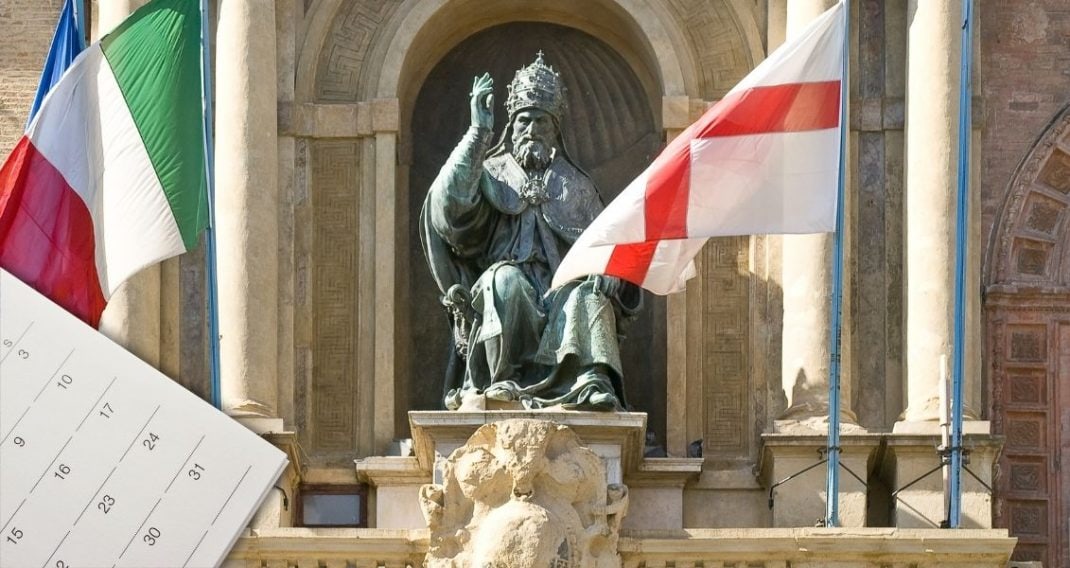He served God but had an illegitimate son, carried out reforms but supported the killing of heretics, was given the name Hugo at birth, but the current calendar system was named after the name he chose after enthronement.
-
1.
Reasons for reforming the old calendar-
1.1.
Why did the error occur?
-
1.1.
-
2.
What is the difference between the Julian and Gregorian calendars? -
3.
What did this mean in practice?
February 24, 1582 the Pope Gregory XIII issued the bull “Inter gravissimas” regarding the calendar reform, which has not yet been fully implemented in Ukraine.
The name of the bull was given by the first two words with which it begins: “Inter gravissimas Pastoralis officii Nostri curas …” – (“Among the most important duties of our pastoral service…”).
Reasons for reforming the old calendar
The reason for the appearance of this bull was the discrepancy between the day of the vernal equinox, which in the 16th century according to the Julian calendar began to fall on March 11, and the day of the equinox, which fell on March 21 in the year 325 after the birth of Christ, when the Christian world adopted the Julian calendar at the Council of Nicaea. For the church, this situation was unacceptable, since the day of the vernal equinox determined the date of the celebration of Easter.
Pope Gregory would hardly like such an explanation, but the devil is in the details.
Why did the error occur?
What were the reasons for the error that accumulated over the years and led to a significant lag between the Julian calendar and the solar one?
The most precise interval between two consecutive passages of the center of the solar disk through the midpoint of the vernal equinox is called a tropical year and is equal to 365.242189670139 days or 365 days 5 hours 48 minutes 45.1875 seconds. (It is important to note that this value is not constant – the tropical year gradually decreases).
It is clear that during the time of Julius Caesar, astronomers did not have the opportunity to calculate the length of the year with such accuracy.
Therefore, the creators of the Julian calendar took as a basis the ancient Egyptian calendar, according to which the length of the year was 365.25 days or 365 days 6 hours. To account for the extra 6 hours, a four-year cycle was created – the first three years of 365 days and the fourth year of 366 days. That is, every fourth year was a leap year. It would seem: only 11 and a half minutes difference from a solar year – what could go wrong?
But every 128 years, 1 extra day appeared in the calendar, and the dates of the Julian calendar gradually began to fall behind the solar calendar.
Thus, for more than 1,200 years of using the Julian calendar from the Council of Nicea, this error led to a shift in the date of the vernal equinox by 10 days. And something had to be done about it.
Why exactly 10 days?
The Nicene Council was held in 325, the calendar reform was carried out in 1582, and the error is 1 day in 128 years. Hence: (1582-325)/128 = 9.82 days ≈ 10 days.
The error was noticed at the beginning of the 14th century, but for various reasons it was not in a hurry to be corrected for more than 250 years.
The Byzantine scientist Isaac Argir considered any corrections to be pointless, since in 1492 he expected the end of the world (this year was supposed to be 7000 years “from the day of the creation of the world”). As you know, not only did the end of the world not come in 1492, but it was the open New World – the American continent.
At the end of the 16th century, the issue of calendar reform was overdue, so Pope Gregory XIII created a special commission that was supposed to choose the best project for a new calendar. After getting acquainted with various options, the commission chose the project of the Italian mathematician and doctor Aloysius Lilius.
On February 24, 1582, Pope Gregory XIII issued a bull on the new calendar, and “good Catholics” learned that this year Christmas would come 10 days earlier. The new calendar came into effect in the fall: residents of some Catholic countries went to bed on October 4 and woke up on October 15.
But rescheduling was only half the story. The developers of the new calendar needed to correct an error that was embedded in the basis of the Julian calendar. The solution to this problem was taken up by the German mathematician and astronomer Christopher Clavius, who proposed a more accurate length of the year – 365.2425 days.
What is the difference between the Julian and Gregorian calendars?
Let’s present the length of the year according to the Julian calendar in the form of fractions:
365.25 = 365 + 0.25 = 365 + ¼
A year consists of 365 days, and the fraction ¼ means that once every 4 years one more day, the 366th, must be added.
Similarly, let’s present the length of the year according to the Gregorian calendar:
365.2425 = 365 + 0.25 – 0.01 + 0.0025 = 365 + ¼ – 1/100 +1/400
As you can see, Clavius made a small but important clarification: the year also consists of 365 days, 1 time in four years should be a leap year, but Once every 100 years, a leap year is skipped, except for every four hundredth year.
What did this mean in practice?
Since the calendar was put into effect in 1582, the nearest leap year should have been in 1584, then 1588, 1592 and 1596. Let’s go further – the year 1600 is divisible by 400, so it is also a leap year, as well as every subsequent fourth year, up to 1700. This year (1700) was divisible by 100 but not divisible by 400, so it was not a leap year and had a standard 365 days. Accordingly, 1800 and 1900 were also not leap years, and already 2000 was a leap year.
This means that the 400-year cycle of the Gregorian calendar has 97 leap years, which is 3 years less than that of the Julian calendar. That is, every 400 years according to the Julian calendar, 3 “extra” days occur.
The Gregorian calendar is also not perfect. Its error compared to the solar calendar is 1 day in 3280 years.
The famous Persian philosopher, mathematician, astronomer, connoisseur of women and wine Omar Khayyam in the 11th century. developed a more accurate calendar than the Gregorian one – its error is equal to 1 day in 4500 years.
It is worth noting that the introduction of the new calendar was not without excesses, including riots, and Pope Gregory even had to threaten opponents of the reform with excommunication. This was an effective method even during the Renaissance, but it would hardly have worked if the Ukrainian churches (Orthodox or Greek Catholic) brought the church calendar into line with the secular one and decided to apply such “sanctions” to those parishioners who, for example, refused celebrate Christmas on December 25.
But at the same time, supporters of celebrating Christmas on January 7 should keep in mind that due to an error in the Julian calendar, Christmas will fall on January 8 from 2101, since according to the Julian (church) calendar, 2100 will be a leap year, but not according to the Gregorian (secular) calendar. .
Now the Gregorian calendar is used in all countries of the world except Ethiopia, Iran, Afghanistan and Nepal. In Ukraine, it was introduced on February 25, 1918 by a law of the Central Rada, almost 336 years after the publication of the papal bull.
- About the author
- Other articles
- “Coca-Cola” is a success story, interesting facts – May 19, 2022
- Mr. Feynman is an outstanding physicist and a great joker – May 11, 2022
- Red poppies as a symbol of memory – May 8, 2022


































